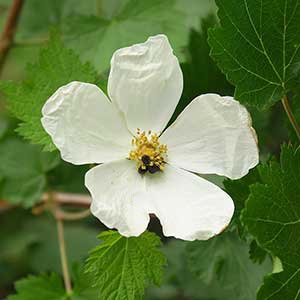Rubus bartonianus
Rubus glaucifolius
Barton's raspberry, bartonberry
Cuyamaca raspberry, San Diego raspberry, wax leaf raspberry
erect, sparsely short-hairy, glabrescent, eglandular, not pruinose.
biennial, creeping, glabrous, eglandular, strongly pruinose;
prickles sparse, erect or slightly curved, weak, slender, 2–3 mm, narrow-based.
deciduous, simple;
stipules lanceolate, 4–6 mm;
blade cordate to broadly ovate, (2–)2.5–4(–5) × (2.5–)3.5–4.5(–5.5) cm, base deeply cordate, 3–5-lobed, lobe apices acute to obtuse, margins coarsely doubly dentate, abaxial surfaces glabrous or sparsely hairy, eglandular or sparsely stipitate-glandular.
deciduous, ternate;
stipules filiform to linear, 3–10 mm;
terminal leaflets ovate to elliptic, 4–8 × 3–7 cm, base tapered or subcordate, often 2-lobed, margins coarsely dentate, apex acute to rounded, abaxial surfaces unarmed, densely white-tomentose, eglandular.
1-flowered.
terminal and axillary, (1–)2–4(–10)-flowered, cymiform.
moderately hairy, eglandular or sparsely stipitate-glandular.
unarmed, finely hairy, stipitate-glandular.
bisexual;
petals white, obovate, (15–)20–25 mm;
filaments filiform;
ovaries glabrous, styles clavate, villous.
bisexual;
petals white, oblong to oblanceolate, 4–8 mm;
filaments laminar;
ovaries white-tomentose.
deep red, hemispheric, to 1 cm;
drupelets 10–30, coherent, separating from torus.
reddish purple, hemispheric to conic, 0.4–1 cm diam.;
drupelets 10–40, coherent, separating from torus.
Rubus bartonianus
Rubus glaucifolius
Of conservation concern.
Rubus bartonianus is distinguished from the other flowering raspberries within its geographic range by its erect, unarmed stems, relatively small, simple leaves with acute to obtuse lobes, deeply cordate bases, sparsely hairy or glabrous abaxial surfaces, relatively large flowers with white petals, and densely long-hairy, clavate styles. The leaves superficially resemble those of Acer glabrum or some species of Ribes.
Rubus bartonianus is most similar to R. neomexicanus but especially R. deliciosus. The species is known only from the Snake River Canyon of Idaho and Oregon.
(Discussion copyrighted by Flora of North America; reprinted with permission.)
Rubus glaucifolius is found in the Sierra Nevada and Klamath mountains as well as the Peninsular and northern Coastal ranges in California, and in adjacent Oregon only in Jackson County.
(Discussion copyrighted by Flora of North America; reprinted with permission.)


